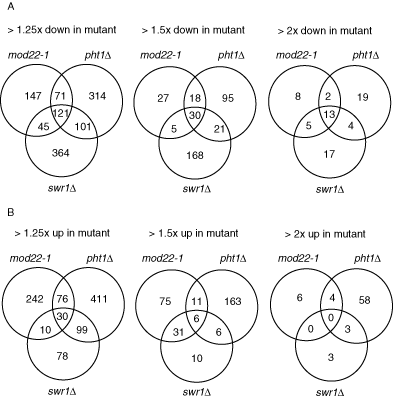Improved tools for efficient mapping of fission yeast genes: identification of microtubule nucleation modifier mod22-1 as an allele of chromatin- remodelling factor gene swr1
- PMID: 19160458
- PMCID: PMC2964509
- DOI: 10.1002/yea.1639
Improved tools for efficient mapping of fission yeast genes: identification of microtubule nucleation modifier mod22-1 as an allele of chromatin- remodelling factor gene swr1
Abstract
Fission yeast genes identified in genetic screens are usually cloned by transformation of mutants with plasmid libraries. However, for some genes this can be difficult, and positional cloning approaches are required. The mutation swi5-39 reduces recombination frequency in homozygous crosses and has been used as a tool in mapping gene position (Schmidt, 1993). However, strain construction in swi5-39-based mapping is significantly more laborious than is desirable. Here we describe a set of strains designed to make swi5-based mapping more efficient and more powerful. The first improvement is the use of a swi5Delta strain marked with kanamycin (G418) resistance, which greatly facilitates identification of swi5 mutants. The second improvement, which follows directly from the first, is the introduction of a large number of auxotrophic markers into mapping strains, increasing the likelihood of finding close linkage between a marker and the mutation of interest. We combine these new mapping strains with a rec12Delta-based approach for initial mapping of a mutation to an individual chromosome. Together, the two methods allow an approximate determination of map position in only a small number of crosses. We used these to determine that mod22-1, a modifier of microtubule nucleation phenotypes, encodes a truncation allele of Swr1, a chromatin-remodelling factor involved in nucleosomal deposition of H2A.Z histone variant Pht1. Expression microarray analysis of mod22-1, swr1Delta and pht1Delta cells suggests that the modifier phenotype of mod22-1 mutants may be due to small changes in expression of one or more genes involved in tubulin function.
(c) 2009 John Wiley & Sons, Ltd.
Figures



References
-
- Bähler J, Wu JQ, Longtine MS, et al. Heterologous modules for efficient and versatile PCR-based gene targeting in Schizosaccharomyces pombe. Yeast. 1998;14:943–951. - PubMed
Publication types
MeSH terms
Substances
Grants and funding
LinkOut - more resources
Full Text Sources
Molecular Biology Databases
Research Materials

